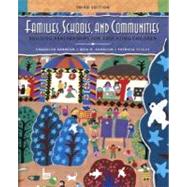
| Home, School, and Community Influences on Children's Lives | |
| Historical and Philosophical Perspectives | |
| Viewing Family Diversity | |
| Parenting the Child | |
| Meeting Child Care Needs from Infancy through School Age | |
| Responsibility for Educating and Protecting Children | |
| Curriculumof the Home | |
| Curriculum of the School | |
| Curriculum of the Community | |
| Effective Social and Cultural Settings for Learning | |
| Traditional and Innovative Strategies for Working Together | |
| Models for Parent--School--Community Partnerships | |
| Bibliography of Children's Books | |
| NAEYC Code of Ethical Conduct | |
| Glossary | |
| References | |
| Index | |
| Table of Contents provided by Publisher. All Rights Reserved. |
The New copy of this book will include any supplemental materials advertised. Please check the title of the book to determine if it should include any access cards, study guides, lab manuals, CDs, etc.
The Used, Rental and eBook copies of this book are not guaranteed to include any supplemental materials. Typically, only the book itself is included. This is true even if the title states it includes any access cards, study guides, lab manuals, CDs, etc.